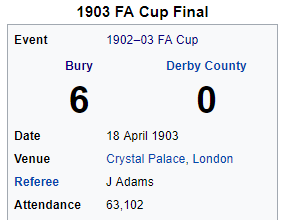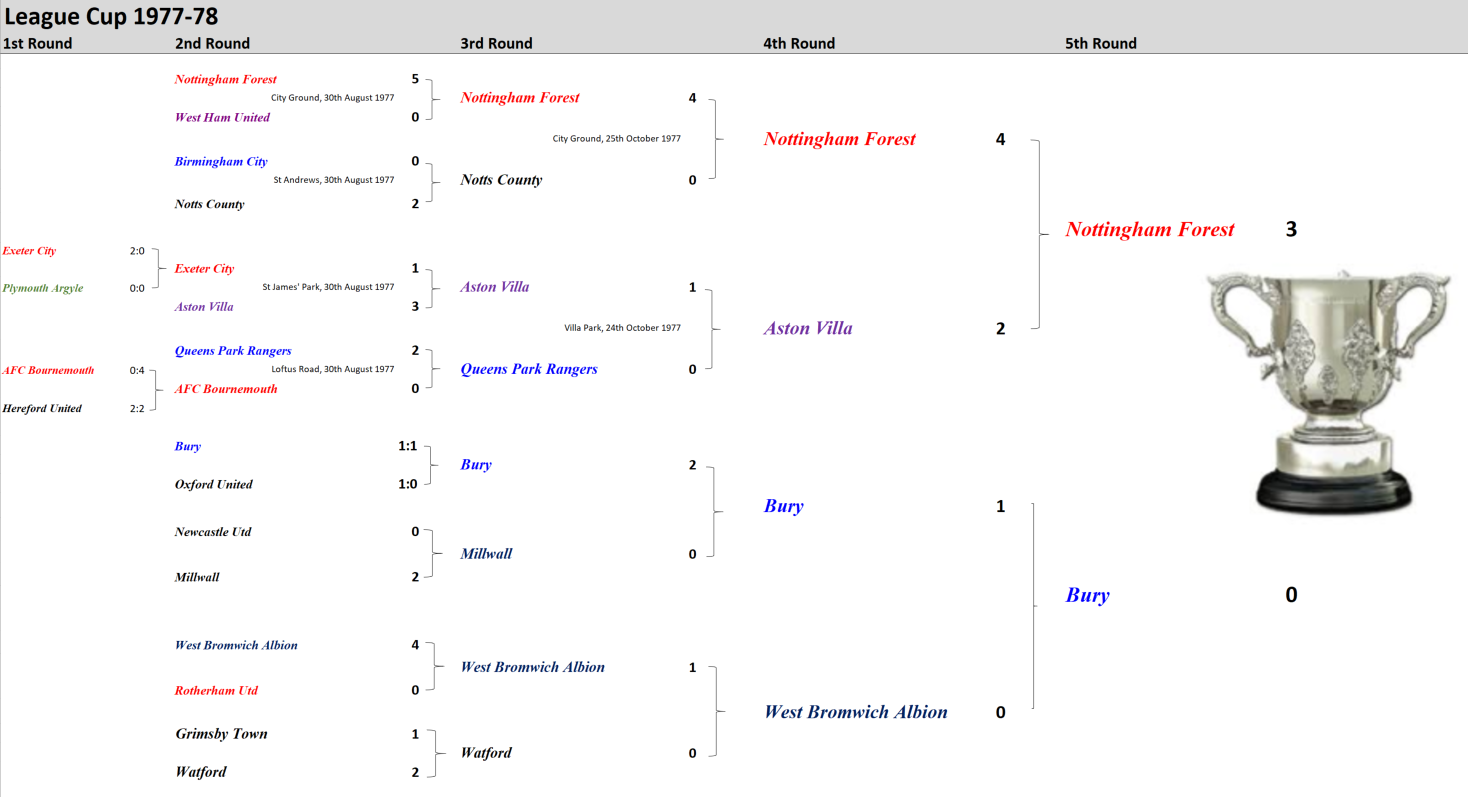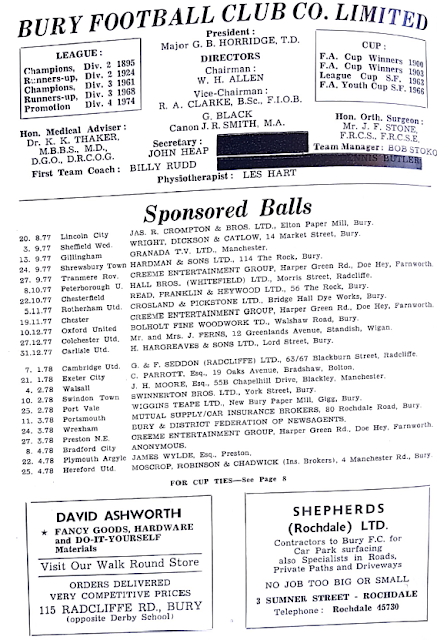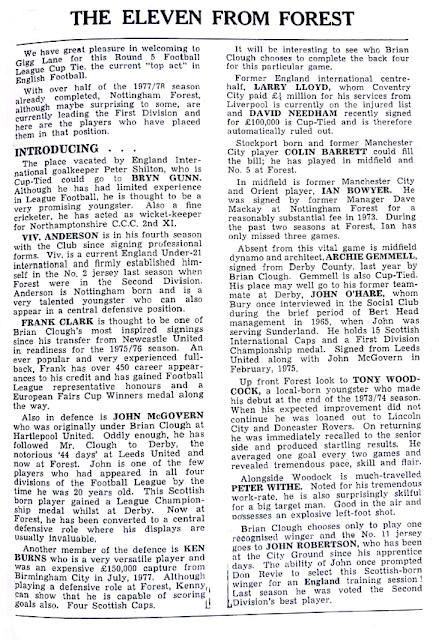You know the answer but before describing my trip to the match let's pay respect to the long history of Bury F.C. and some of their great historical highlights.
The North West is Football Mad
Now, I consider myself pretty good at geography but I'm always getting confused as to the relative position of the football clubs in the North-West of England. There are just so many of them.
In the map below I've marked current league clubs in red and ex-league clubs (or National Premier League clubs who have never been "in" the league - I consider the National League as pretty much division five these days anyway) in claret.
I reckon there's 31 there by my counting. Let me know if I've missed any.
 |
| There are easily more than 30 professional clubs in the North West |
Of course a big part of the history of professional football in England is tied to the rise of industrialisation and the mills of the north west. The factory owners soon cottoned on that productivity would rise if the workers had Saturday afternoon off to watch the football - especially if their team won. That's where most of the money came from to fuel the rise of professionalism. If you scan your eyes over that map you see many of the early great professional football clubs, such as Preston North End and Blackburn Rovers.
Bury was no different. Textile production was a major factor in its growth towards the end of the 18th century and in the late 19th century all the local towns were getting into football to keep the proletariat down (or "up" emotionally). All of this is beautifully described in James Waivin's book "The People's Game" by the way. A very good read.
 |
| Great Book about football history |
Is it bUry, or "bEry"?
Before going on, we should all know how to say "Bury" or at least know why we're saying it one way or another.
When most people see "Bury" written down, they read it (mentally at least) as if it were spelled "berry". I do it too, which strikes me as odd as I usually don't shy from using a proper "u" sound when I see one. Northern lad, see? Apparently, even in Bury half the people pronounce it "Berry". It would seem that common use of the verb "to bury" which is pronounced "berry" has rubbed off on people in the area, even town dwellers themselves. In the past, though, apparently it used to be 'bUry'.
Anyway, say it how you like!
History of 'The Shakers'
Bury are a famous old club. Formed in 1885, they joined the league in its seventh season, just two after Forest. In the period before the first world war they closely matched Forest in the league, having an average league place just above us.
The time around the turn of the last century was a glorious period for both of the clubs. In the six years from 1899 until 1903 Forest won the F.A. Cup once and Bury twice.
Here's a good trivia question for you:
Which team has the best record in F.A. Cup finals in the entire history of the competition - a 100% record with an average score of 5-0?
Answer, of course: Bury.
They won the cup twice in four years, both at Crystal Palace. The first was a 4-0 win and the second 6-0!
Here's a good trivia question for you:
Which team has the best record in F.A. Cup finals in the entire history of the competition - a 100% record with an average score of 5-0?
Answer, of course: Bury.
They won the cup twice in four years, both at Crystal Palace. The first was a 4-0 win and the second 6-0!
F. A. Cup 1899-1900: Bury 4 Southampton 0
Forest had won the cup themselves for the first time just two seasons before this and had another good cup run this season too, meeting Bury in the semi-final, on April 24th 1900. They drew 1-1 at the Victoria Ground, Stoke but Bury won the replay the following Wednesday, at Bramall Lane, Sheffield, 3-2 to get to the final.
To get to the semis, Bury had beaten Burnley away 1-0, Notts County 2-0, after a 0-0 draw at Meadow Lane and Sheffield United at home 2-0 in the quarter finals. Forest, meanwhile, had two 3-0 home wins against Grimsby and Sunderland and then a 1-0 quarter final home win against Preston after a draw at Deepdale.
Meeting Bury in the final at Crystal Palace were non-league Southampton. A crowd of nearly 69,000 packed the terraces for what turned out to be a very one-sided match.
Look at these great action images from the match...
Look at these great action images from the match...
 |
| Bury F.C. F. A. Cup winners for the First time |
 |
| As good as it ever got (collectively) for Forest and Bury (and Notts County) at the turn of the last century |
F. A. Cup 1902-1903: Bury 6 Derby County 0
Bury followed up their first trophy, just three years later, with an even more amazing second cup win. Excuse my smug face, but the second win was against Derby County and the score remains, even today, the biggest ever margin in an F.A. Cup Final.
Bury hadn't had a high scoring cup run. Their goal scoring explosion just seems to have been timed right. To reach the final, Bury had three 1-0 wins, home to Wolves, away to Sheffield United and home to Notts County, before they dispatched Aston Villa 3-0 in the semi-finals. But nobody saw the final score coming...
Bury hadn't had a high scoring cup run. Their goal scoring explosion just seems to have been timed right. To reach the final, Bury had three 1-0 wins, home to Wolves, away to Sheffield United and home to Notts County, before they dispatched Aston Villa 3-0 in the semi-finals. But nobody saw the final score coming...
In 1903 Bury were one of the early English football power-houses, at least in terms of F.A. Cup wins. Only three clubs had won it more than them in the first 30 tournaments.
 |
| F. A. Cup Winners Table in 1903 |
Gigg Lane
Bury have played at the Gigg Lane ground for their entire history.
 |
| Gigg Lane is South of the town center |
Here's an image from 1905 which looks a bit like a Lowry painting with the terraced housing and dark satanic mills on the horizon.
 |
| Bury v Sunderland at Gigg Lane in 1905 |
This was my 39th English league ground visited.
Bury in the 1920s
As we've seen time and time again in these historical reviews, Forest's period between the wars was really quite poor. And it should be no surprise that Bury completely dominated this period over Forest too. Forest finished above Bury for only 5 of the 21 inter-war seasons and on average they finished 7 places above us.This peaked in the 1925-26 season when Bury finished 4th in the First Division, their highest ever league position, and Forest were 17th in Division Two, 35 places below them.
 |
| Bury's best ever season - 4th in the First Division |
Here's a classic old clip of the two sides playing at that time of transition in a second division clash on 3rd December 1955 on a snow covered patch at Gigg Lane. Forest won 2-1 in what was pretty much a mid-table clash at the time. But the next season Forest would get promotion to the First Division whilst Bury would go down to Division Three (North) for the first time in their history.
 |
| Forest and Bury finally parted ways and ne'er the twain shall meet again in the league (so far) |
Down into the 3rd & 4th Tiers
Bury did return for a six year spell in division two after winning the third division in 1960-61. They got as high as 8th a couple of years later - and had a great run in the League Cup, see below - and then did a yo-yo between the third and second divisions before finally getting relegated to the third and then the fourth tier in 1971-72. They reached their lowest league position (at the time of this game, they've gone lower still since then) of 12th in the 4th division in 1973.I still feel a little ashamed that I've always seen Bury as a lowly club. This is because when I was starting to take an interest in football, they happened to languishing in the bottom two divisions. I never appreciated their history until relatively recently.
 |
| Programme for League Cup Semi v B'ham |
Bury beat Lincoln City - then struggling in the 4th - in the second round. Then in the third they knocked first division Sheffield United out 3-1 at Gigg Lane.
In the 4th round they beat 3rd division strugglers Bristol Rovers, again by 3-1.
So, to the quarter finals where they played Leyton Orient away. This might sound a relatively easy game from today's perspective but this was actually Orient's one season in the top flight, under the brilliant management of Johnny Carey who would later take Forest to their (nearly) glory years in the mid 1960s.
The semi-final itself, played over two legs, was a close affair. Birmingham won the first leg at St Andrews' 3-2 and Bury came close to getting to the final with a 1-1 draw at Gigg Lane. So they only lost 3-4 on aggregate. Birmingham went on to beat their local rivals Aston Villa in the final, again over two legs in those days.
So, there you have it. Bury had been to the semi-finals of the League Cup, whereas Forest hadn't. Playing Bury away in the quarter finals was already our best ever run in the competition.
League Cup 1977-78
So, to this season and the highlight for Bury was their victory over first division West Bromwich Albion in the 4th Round. Tonight though, they faced the tricky trees on the form of their lives.
The Teams
This was the fourth of six games for Forest in January. They'd certainly been clocking up the games. They played 5 in August, 4 in September, 7 in October, 5 in November and 6 in December, so this was the 31st game of the season. Incredible, from today's perspective, is that Forest had used only 17 players in these games and one of those, Chris Woods, was only used because Peter Shilton was cup-tied. Tonight, though, Forest had to make three changes due to having cup-tied players, not just one. |
| Bob Stokoe |
For a change then, it was the opposition, not us, who were unchanged. The manager that picked the team for Bury that night? Bob Stokoe, the man who had managed Sunderland to that famous 1-0 F.A. Cup Final win against Leeds United in 1972.
At this point I want to thank a reader of this blog post, David Holden, who is a Bury fan. He took the trouble to write to me at he end of 2020 to tell me that Bob Stokoe was actually involved in the incident that ended Brian Clough's playing career, when Sunderland played Bury at Roker Park on Boxing Day 1962. Cloughie collided with Bury goalkeeper, Chris Harker, and their center half, Stokoe, did not show our Brian any sympathy.
"Get up ya bastard, there’s nowt a matter with ya!' he called, as if his career-ending injury was being faked.
Apparently they never spoke to each-other again.
There's a video clip showing an interview with Clough about it, including footage of the incident here... (again, thanks to David Holden for the link.)
Bury
1 John Forrest, 2 Gerry Keenan, 3 Keith Kennedy, 4 Dave Hatton, 5 Bill Tucker, 6 Alan Whitehead, 7 Brian Stanton, 8 John Thomson, 9 Andy Rowland, 10 Ian Robins, 11 Jimmy McIlwraith.
Nottingham Forest
1 Chris Woods, 2 Viv Anderson, 3 Frank Clark, 4 John McGovern, 5 Colin Barrett, 6 Kenny Burns, 7 Martin O'Neill, 8 Ian Bowyer, 9 Peter Withe, 10 Tony Woodcock, 11 John Robertson.
Goals : Martin O'Neill 1, Ian Bowyer 1, John Robertson 1.
Attendance 21,500
The attendance is significant for me personally as it is the first time in this series of blogs that the attendance of the match I am reporting on is actually less than the total number of blog views I've had. So, thanks to anyone who's read any of these articles, or even just clicked on the link and then gone away again when the page loaded! (Blog 26 - for the 4-0 win at Man U still has the most views at over 2,500. Shilton's debut is No 2 and the Liverpool game on Boxing Day is No 3.)
The Game
This was the 89th time Forest had played Bury in a competitive match, the first time in the League Cup, and our record, once again, had been pretty poor.Now, this might be memory playing tricks on me here, but I have a strong feeling that I went to this game with my mate Gary on Barton's buses. If so, I am sure on the bus would have been an old (looked old to us at the time but probably younger than I am now!) chap we called "radio". I have no idea what his name was but as you might have guessed he always took a pretty big radio with him to listen to the football results and reports on the way home.
Having left university (I still thought, forever) I now had got myself a job at Monarch Textiles, a net curtain factory in Kirkby-in-Ashfield, where Gary worked and so that's probably why we went to this game together on the bus. With money coming in I didn't rely so much on charitable lifts from friends.
We stood in the away end (I think called the "Cemetery End"). Again, memory doesn't serve me well here so I rely on the trusty John Shipley and his account in 1977/78 Champions Nottingham Forest.
Having scored 5 at home to West Ham, 4 at home to Notts County and Aston Villa in the previous rounds some Forest fans were doubtless expecting at least as many goals this Tuesday night. As always though the "underdogs" raised their game and Forest's slipped a little.
Forest took the lead in just the eighth minute, settling the nerves. Robbo cross. Withe out-jumps the defence to head. It bounced off a Bury defender straight Ian Bowyer, 1-0.
Bowyer was clearly keen to impress Cloughie after missing the last nine starts in the league. I do remember being pleased to see him and Frank Clark back in the team and impressed that Colin Barrett could so easily switch to the back four.
Forest attacked more and Bury brought Chris Woods into the action a little but it remained 1-0 at half time.
Martin O'Neill smashed in the second ten minutes into the second half and John Robertson added a glorious 3rd just 12 minutes before the end with a run at goal from inside his own half ending with a powerful shot that crashed against the underside of the bar into the net.
A very, very late consolation would arrive for those greedy Forest fans who were expecting more than just three goals, as ironically, Forest would play a League Cup tie at Gigg Lane, Bury again in a couple of years (September 1980) and win 7-0.
Other 5th Round Ties
The other games in the quarter finals were watched by an average of over 36,000 fans. Liverpool, like Forest, had a tricky away fixture at a third division opponents, Wrexham. Maybe trickier, as playing in North Wales must have been a bit of local derby for Liverpool.In a feisty encounter that was 1-1 at half time, a Kenny Dalglish hat-trick won it for Liverpool...
The other two ties, played the following night, were all big first division affairs. Leeds brushed in-form Everton aside 4-1 with goals from Tony Currie, Peter Lorimer (2) and Eddie Gray. Dave Thomas got the consolation for Everton. Manchester City and Arsenal drew 0-0 at Maine Road but a Liam Brady goal won the replay for Arsenal in front of almost 58,000 at Highbury.
So, Forest were through into the League Cup semi-finals for the first time.
The draw for the two-legged matches:
Nottingham Forest v Leeds United
and
Liverpool v Arsenal
But for Forest, it was back to league action next week and a home tie against Arsenal, who were really hitting some scary form now. Another tough test for the reds.




























this is fabulous stuff! Bury fan here - was at the game aged 12 :) It's one of those nights that sticks in the mind. I remember 2 things : Robertson's goal - it was such class that you didn't care about the result. And the other thing I remember is the Forest fans absolutely packed behind the goal ( Bury used to get about 3-4000 in for home games, half of Nottingham must have been there). They weren't intimidating, they just seemed ecstatic - not surprising really. One thing, in my recall, the Forest fans were in the other end of the ground (Manchester Road end), maybe because it was bigger and you had more fans. Anyway, thanks for the blog- brilliant, I even remember the programme that you put up there - it was a special night for Bury fans to have that Forest team in town. J.
ReplyDeleteThanks very much for your kind comments about my blog and for adding your own memories.
DeleteIsn't it funny (and wonderful) that two people, otherwise complete strangers, are united forever by going to a memorable football match. This is what it's all about for me.
Was there my self and thought John Robertson and how he stuck to the byline with his soaks rolled down was brill Notts Forest a great team in the late 70s
ReplyDeleteForest came back in 1980 in the 3rd round of the league cup as European champions and trumped Bury 0-7 at Gigg Lane
This comment has been removed by the author.
ReplyDelete